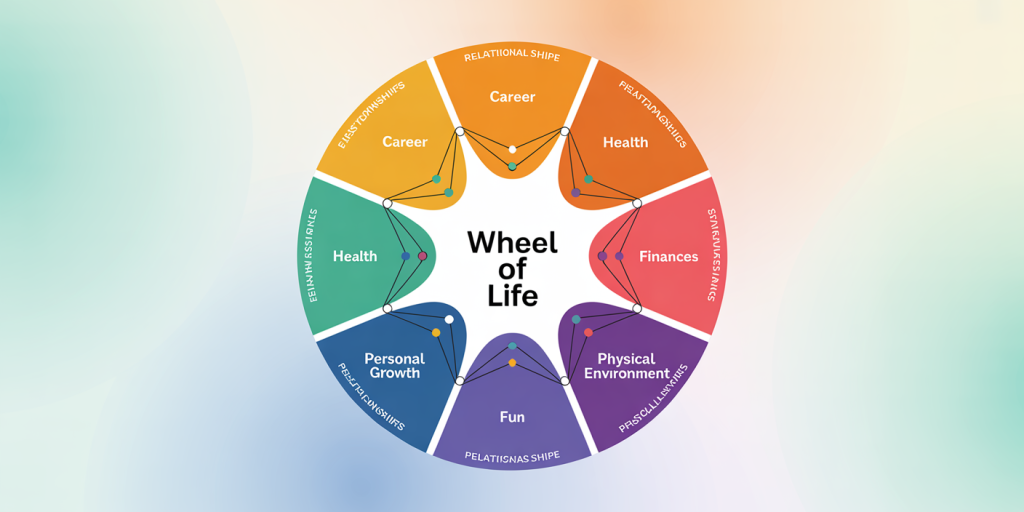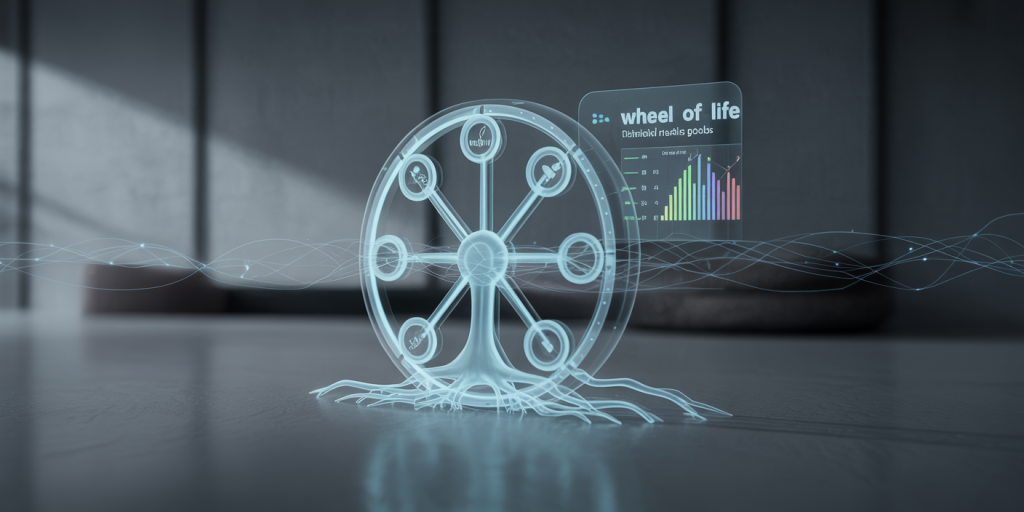Achieving personal balance is a lifelong pursuit that involves regularly evaluating critical areas of life to ensure well-being and satisfaction. The Wheel of Life is a widely recognized tool that individuals, coaches, and professionals use to gain insights into their current life situation. This method visually represents life’s most important segments, allowing users to assess which areas need attention and improvement in order to foster a more balanced lifestyle. In today’s fast-paced and multidimensional world, tools like the Wheel of Life empower people to set meaningful goals that nurture harmony across various life domains.
The effectiveness of the Wheel of Life lies in its simplicity combined with its comprehensive overview. By breaking down life into key categories such as Career, Health, Relationships, and Personal Growth, it helps individuals pinpoint where their satisfaction levels are high and where they are lacking. This methodology not only supports reflection but also guides actionable planning, thereby improving overall quality of life. A 2022 study published in the *Journal of Positive Psychology* emphasizes that self-assessment tools, including the Wheel of Life, significantly contribute to personal development and goal achievement.
Understanding the Wheel of Life Framework
The Wheel of Life typically consists of a circle divided into equal segments, each representing an area of life that contributes to overall happiness and fulfillment. Commonly included categories are Career, Finances, Health, Family, Relationships, Personal Growth, Fun, and Physical Environment. Users rate their level of satisfaction in each segment on a scale, often from 1 to 10, and plot these scores along the corresponding slice of the wheel. Connecting the points forms a shape that visually depicts balance or imbalance.

For example, a professional named Sarah noticed her wheel was heavily skewed toward Career and Finances but showed significantly low scores in Health and Relationships. By using this insight, she realized that her long work hours were affecting her physical well-being and personal life. This realization motivated Sarah to allocate time to exercise and reconnect with friends, resulting in improvements in both health and social satisfaction within three months.
A comparative analysis of the satisfaction scores also highlights the uneven distribution of energy and time across various life areas. When the wheel’s shape is irregular, it often indicates imbalance, whereas a more rounded, even shape suggests a harmonious life. According to a 2021 survey by the International Coaching Federation (ICF), 67% of respondents using the Wheel of Life reported improved life balance after addressing low-scoring areas identified through the tool.
| Life Area | Satisfaction Score (1-10) | Example: Sarah’s Original Score | Example: Sarah’s Scores after 3 Months |
|---|---|---|---|
| Career | 8 | 9 | 8 |
| Finances | 7 | 8 | 8 |
| Health | 4 | 3 | 7 |
| Relationships | 5 | 4 | 7 |
| Personal Growth | 6 | 5 | 6 |
| Fun | 5 | 4 | 6 |
| Physical Environment | 6 | 6 | 7 |
Practical Steps to Use the Wheel of Life Effectively
Using the Wheel of Life effectively requires more than just marking scores. It demands honest reflection, analysis, and planning. Start by selecting relevant areas that truly resonate with your life circumstances; the traditional eight segments can be customized to include domains like spirituality, creativity, or community involvement. This flexibility ensures the tool remains personally meaningful.
Once categories are finalized, allocate time in a distraction-free environment to rate satisfaction levels critically. It helps to ask yourself guiding questions like: “How fulfilled do I feel in this area?” or “Is this aspect taking up too much or too little of my attention?” After plotting your scores and connecting the dots, take a step back and observe the visual pattern. What strikes you as out of alignment? Which areas require immediate focus?
Consider a case where an entrepreneur, Michael, used the Wheel of Life after noticing burnout signs. His assessment revealed high scores in Career and Finances but very low ratings in Health and Personal Growth. Rather than ignoring these red flags, Michael developed a plan to reintroduce a workout routine and enroll in courses that reignited his passion. Within six months, his overall satisfaction scores rose, demonstrating the practical power of targeted actions informed by the Wheel of Life.
Moreover, this tool can be incorporated into regular check-ins—monthly or quarterly—to track progress and recalibrate goals. Research in the *Harvard Business Review* (2020) supports regular self-assessments, showing they enhance motivation and accountability toward personal development objectives.
Benefits of Assessing Personal Balance with the Wheel of Life
Using the Wheel of Life offers numerous benefits that extend beyond mere self-reflection. One major advantage is clarity. By viewing life segments side-by-side, individuals gain a holistic perspective on how their life feels in totality rather than isolating issues. This broader viewpoint can prevent tunnel vision, which often leads to neglecting important life domains.
Additionally, the tool promotes proactive management of time and energy. For example, a graphic designer named Emily discovered through her Wheel of Life evaluation that she was heavily investing time in Fun and Social Life but neglecting Finances and Career Development. The visual imbalance encouraged Emily to set clear goals for upskilling and budgeting. Within a year, she transitioned to a higher-paying role while maintaining a rich social life.
The Wheel of Life also fosters balanced goal setting. Instead of purely focusing on one life area, such as career advancement, users are encouraged to pursue comprehensive improvement. Data from a 2023 study by the American Psychological Association suggests that individuals with balanced lives report 20% higher overall life satisfaction and 30% lower stress levels compared to those with fragmented focus.
| Benefit | Description | Supporting Evidence |
|---|---|---|
| Holistic clarity | Comprehensive visualization of life | APA, 2023: Balanced individuals report higher satisfaction |
| Goal prioritization | Identifies critical areas needing focus | HBR, 2020: Self-assessment drives motivation |
| Enhanced accountability | Encourages regular review and adjustment | ICF, 2021: 67% improved balance post-assessment |
| Stress reduction | Promotes balanced lifestyle choices | APA, 2023: Balanced life reduces stress by 30% |
Common Challenges and How to Overcome Them
Despite its simplicity, many users face challenges when using the Wheel of Life. The biggest hurdle is often honesty. People may inflate or deflate scores due to fear of facing uncomfortable truths. When this happens, the tool loses its effectiveness. It is essential to approach the process with openness and a willingness to confront where imbalances exist.
Another challenge is neglecting the follow-up. Marking scores is only the starting point; the true value lies in setting goals and taking deliberate actions. Some individuals fail to develop or adhere to improvement plans, resulting in stagnation. Incorporating the Wheel of Life into coaching sessions or peer accountability groups can help maintain momentum.
A practical example involves John, a mid-level manager who routinely scored low on Personal Growth but hesitated to prioritize it due to workload stress. After involving a mentor, John committed to a monthly book club and online course, gradually improving not just his personal growth score but also his overall sense of fulfillment. This case illustrates the importance of external support and disciplined follow-up.
Customizing the Wheel of Life for Different Life Stages
The dynamic nature of life means that priorities and perceptions of balance change over time. Thus, customizing the Wheel of Life is vital to accommodate different life stages and cultural contexts. Young professionals may prioritize Career and Education segments, while retirees might emphasize Health, Family, and Leisure.
For parents, categories such as Parenting and Community Involvement might be crucial additions. For people going through transitions like divorce or relocation, Emotional Well-being and Social Connections may need special focus. Customized Wheel of Life assessments become tailored reflection tools that better address unique life phases, enhancing relevance and motivation.
A case study involving a group of mid-career professionals in a 2022 workshop showed that when given options to modify the traditional Wheel, satisfaction with the self-assessment process increased by 40%. This led to more precise goal setting and faster progress in targeted areas.
| Life Stage | Typical Wheel Categories | Customized Options |
|---|---|---|
| Early Career | Career, Education, Relationships, Finances | Personal Development, Networking |
| Parenthood | Family, Health, Career, Personal Growth | Parenting, Community, Time Management |
| Retirement | Health, Leisure, Family, Finances | Spirituality, Hobbies, Social Engagement |
Future Perspectives: Evolving the Wheel of Life for Digital and Holistic Wellness
Looking ahead, the Wheel of Life is evolving, integrating technology and new wellness paradigms. Digital apps now enable real-time tracking, data visualization, and AI-driven suggestions to support personalized growth plans. This offers richer insights and encourages habitual use, which amplifies the tool’s benefits.

In addition, the future of the Wheel of Life embraces a more holistic wellness model incorporating mental health, environmental sustainability, and social impact. For instance, a new dimension called “Planet Health” appears in some progressive wheel templates, encouraging users to evaluate their ecological footprint alongside personal domains. This evolution aligns with global trends emphasizing interconnected well-being.
Furthermore, virtual reality (VR) environments are being developed to make the assessment process more immersive, intuitive, and engaging. As personal and professional lives continue to intertwine within complex digital ecosystems, tools like the Wheel of Life will be indispensable for fostering mindful living, adaptability, and balanced success.
In summary, the Wheel of Life remains a versatile, impactful, and accessible framework for assessing personal balance and setting actionable goals. Its ongoing innovation will harness technology and broaden its scope, helping individuals worldwide navigate the complexities of modern life more thoughtfully and effectively.


Deixe um comentário